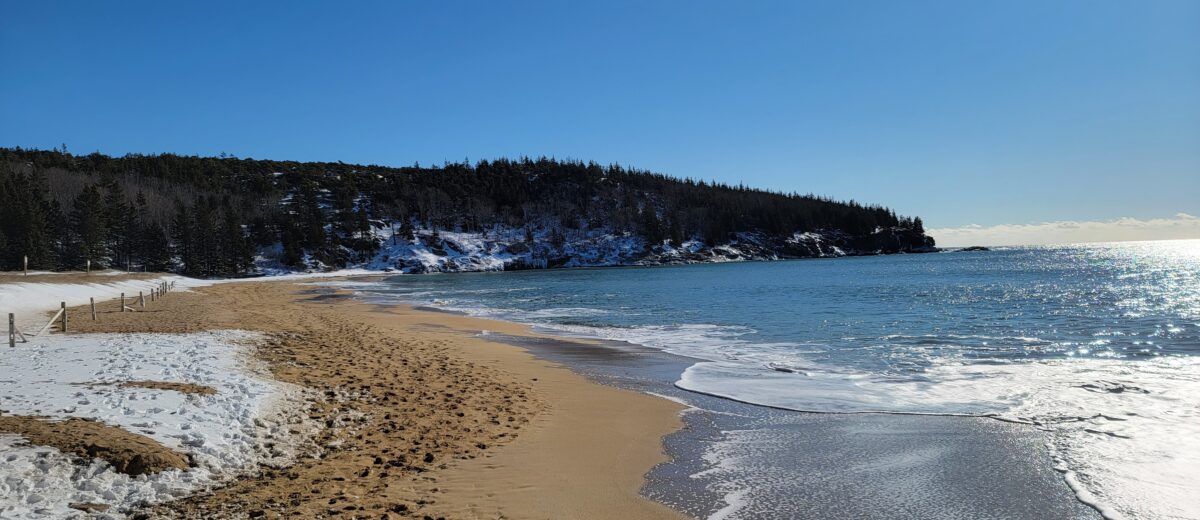story + photos by Catherine Schmitt
Snow covers the sand dune, except for the blond tips of beach grass which the wind has combed to one side. The waves, deep blue and rimmed with white, turn over sand grains with each surge. The waves recede, and the wet beach shines in the winter sun.
Beaches are always unstable to some degree—sand wants to move. But Sand Beach has persisted for thousands of years, in part due to its geography. Its south-facing direction captures sand moved ashore by wind and waves, and steep granite peninsulas on both sides keep sand from being carried away. A ledge of rock offshore, “Old Soaker,” helps break up the surf as it enters the cove. The water slows enough to allow the finer particles to settle and accumulate.
Biology, too, has helped sustain the beach, as the “sand” is really tiny fragments of shell. Coastal geologists have estimated that seventy percent of the beach is bits of barnacle, mussel, urchin, and snail, making Sand Beach a “carbonate beach,” and a rarity for having so much shell so far north. Sand is regularly resupplied, as a new generation of marine animals settles among the pebbles and rocks along the low tide line of the cove each year.
The seasons take their turn. Winter waves scour and sweep the beach, pulling fine sand deeper into the cove, leaving behind coarser grains, often forming a shelf or scarp or series of ridges across the beach. At the far eastern end of the beach, a tidal inlet meets freshwater flowing to the sea from wetlands behind the dune. The freshwater originates with rain and snowmelt from the sides of Champlain Mountain and The Beehive.
Summer restores what winter depletes. Summer winds come from the south, and waves push sand onto the beach, covering the low-tide rocks and sealing off the inlet with fine, pinkish gold sand. New layers of sand are added to the dune, which helps hold the beach in place. The dune itself, however, is fragile and the park asks visitors to help protect it.
The greatest forces shaping Sand Beach are storms, including hurricanes and the winter storms known as Nor’easters.
After the Blizzard of 1978, University of Maine oceanographers Bruce Nelson and Ken Fink found the beach flattened, and ten to fifteen feet of dune eroded away. An April Nor’easter in 2007 (the Patriot’s Day Storm) destroyed the dune fence, eroded the front of the dune, and yanked all of the sand off the beach, exposing the large boulders that lay beneath, and the remnants of an early twentieth century shipwreck. The shipwreck, or what is left of the shipwreck, is a protected resource.
Over eight vertical feet of sand was carried away in just that one storm, according to Park Ranger Michael Marion. But the sand didn’t go very far. “Most of the sand stayed in the cove, and the beach slowly rebuilt over the ensuing few years as the sand was re-deposited on the beach.”
These days, storms are becoming stronger and more frequent, and the high tide is getting higher. Average sea level—already eight inches higher than it was in 1950—is rising at an increasing rate, now over an inch per decade. Waves regularly reach the dune and the stairs leading down to the beach from the parking lot.
A storm in October 2019 caused a small landslide on the western end of the beach, which is bordered by a bluff of sand and clay. Erosion at the base of the bluff has exposed tree roots, adding to its instability.
When the winter winds howl and the ocean thunders against the shore, it it is hard to imagine the park in any other season. But soon the winds will shift, and the sand will be back on the beach, just in time for summer.
This story originally appeared on nps.gov
